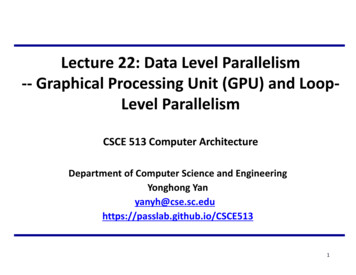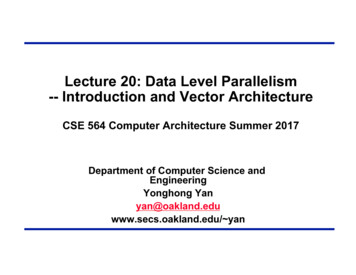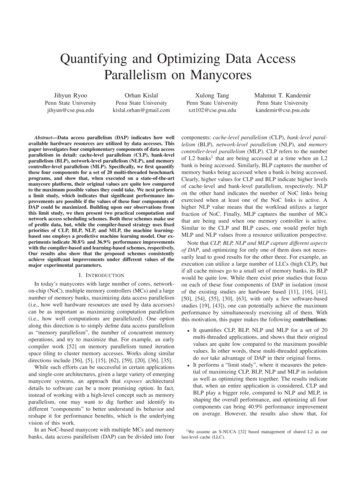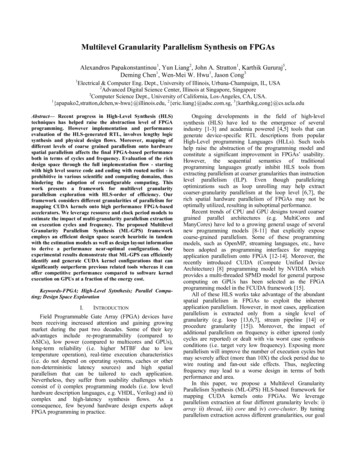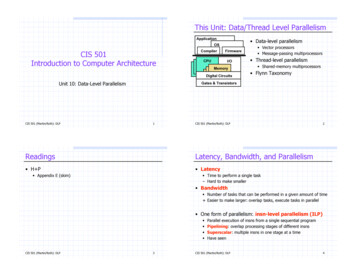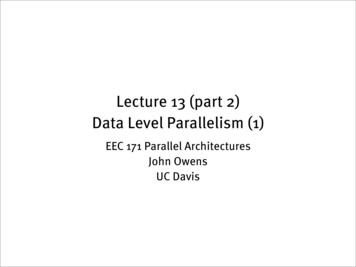
Transcription
Chapter 4Data-Level Parallelism inVector, SIMD, and GPUArchitectures.We will cover sections 4.1, 4.2, 4.3,and 4.5 and delay the coverage ofGPUs (section 4.5)1Introduction SIMD architectures can exploit significant datalevel parallelism for: SIMD is more energy efficient than MIMD matrix-oriented scientific computingmedia-oriented image and sound processorsOnly needs to fetch one instruction per data operationMakes SIMD attractive for personal mobile devicesSIMD allows programmer to continue to thinksequentially2
SIMD Parallelism Vector architecturesSIMD extensionsGraphics Processor Units (GPUs) For x86 processors: Expect two additional cores per chip per yearSIMD width to double every four yearsPotential speedup from SIMD to be twice that fromMIMD!3Vector Architectures Basic idea: Read sets of data elementsinto “vector registers”Operate on those registersDisperse the results back intomemoryRegisters are controlled bycompiler Used to hide memory latencyLeverage memory bandwidth4
RV64V Example architecture: RV64V Loosely based on Cray-1Vector registers Vector functional units Fully pipelinedData and control hazards are detectedVector load-store unit Each register holds a vector (32 elements, each 64 bits long)Register file has 16 read ports and 8 write portsFully pipelinedOne word per clock cycle after initial latencyScalar registers 32 general-purpose registers32 floating-point registers5RV64V Instructions vadd.vv: add two vectorsvadd.sv: add a scaler to a vectorvld, vst: vector load and vector store from addressExample: DAXPYfldF0,a; load scalar avldV1,Rx; load vector Xvmul.vsV2,V1,F0; vector-scalar multiplyvldV3,Ry; load vector Yvadd.vv; addV4,V2,V3vstV4,Ry; store the resultRequires 6 instructions vs. almost 250 for RISC V6
Vector Execution Time Execution time depends on three factors: RV64V functional units consume one elementper clock cycle Length of operand vectorsStructural hazardsData dependenciesExecution time is approximately the vector lengthConvoy Set of vector instructions that could potentiallyexecute together7Chimes Sequences with read-after-write dependencyhazards can be in the same convey via chainingChaining (within a convoy) Allows a vector operation to start as soon as theindividual elements of its vector source operandbecome availableChime Unit of time to execute one convoym convoys executes in m chimesFor vector length of n, a chime n clock cycles8
,V2,V3V4,RyConvoys:1vld2vld3vst;load vector X;vector-scalar multiply;load vector Y;add two vectors;store the sumvmul.vsvadd.vv3 chimes, 2 FP ops per result, cycles per FLOP 1.5For 32 element vectors, requires 32 x 3 96 clock cycles9Challenges Start up time Latency of vector functional unitAssume the same as Cray-1 Floating-point add 6 clock cyclesFloating-point multiply 7 clock cyclesFloating-point divide 20 clock cyclesVector load 12 clock cyclesImprovements: 1 element per clock cycleNon-32 long vectorsIF statements in vector codeMemory system optimizations to support vector processorsMultiple dimensional matricesSparse matricesProgramming a vector computer10
Multiple Lanes Element n of vector register A is “hardwired” to element n of vectorregister B Allows for multiple hardware lanes11Vector Length Register Vector length not known at compile time?Use Vector Length Register (VLR)Use strip mining for vectors over the maximum vector length (MVL):low 0;VL (n % MVL); /*find odd-size piece using modulo op % */for (j 0; j (n/MVL); j j 1) { /*outer loop*/for (i low; i (low VL); i i 1) /*runs for length VL*/Y[i] a * X[i] Y[i] ; /*main operation*/low low VL; /*start of next vector*/VL MVL; /*reset the length to maximum vector length*/}Vector operation12
Vector Mask Registers Consider the loop:for (i 0; i 32; i i 1)if (X[i] ! 0)X[i] X[i] – Y[i]; Use vector mask register, VM, to “disable” elements:vsetpcfgivldvldfldvpnevsub.vvvstvdisable 1v0,Rxv1,RyF0,#0p0, v0, F0v0, v0, v1v0,Rx;Enable 1 predicate register;load vector X into V0;load vector Y;load FP zero into F0;sets p0(i) to 1 if v0(i) ! F0;subtract under vector mask;store the result in X; disable predicate registersGFLOPS rate decreases!13Memory Banks Memory system must be designed to support high bandwidthfor vector loads and storesSpread accesses across multiple banks Control bank addresses independentlyLoad or store non sequential wordsSupport multiple vector processors sharing the same memoryEx: Assume the latency of a memory bank is 12 cycles If 32 interleaved memory banks, If 16 interleaved memory banks, Can load a 32 element vector in 12 32 44 cyclesCan load a 32 element vector in 44 cyclesIf 8 interleaved memory banks, The bank 0 delivers 4 elements at cycles 12, 24, 36 and 48Bank 7 delivers 4 elements at cycles 20, 32, 44 and 56Can load a 32 element vector in 56 cycles14
Stride The matrix DD is storedrow-wiseLoadingwith strideConsider:for (i 0; i 32; i i 1)for (j 0; j 32; j j 1) {A[i][j] 0.0;for (k 0; k 32; k k 1)A[i][j] A[i][j] B[i][k] * D[k][j];} Must vectorize multiplication of rows of B with columns of DUse vlds (vector load with stride) to load the colums of a matrix into avector. vlds v, (R1, R2) v[i] address(R1 i R2)Bank conflict (stall) occurs when the same bank is hit faster thanbank busy time: #banks / LCM(stride,#banks) bank busy time15Scatter-Gather AGatherConsider:for (i 0; i n; i i 1)A[K[i]] A[K[i]] C[M[i]]; Use vldx (load using index vector) , and vstx: vldxvldvldxvldvldxvadd.vvvstxv1, (R1, v2) v1[i] address(R1 v2[i])Vk, RkVa, (Ra,Vk)Vm, RmVc, (Rc,Vm)Va, Va, VcVa,(Ra,Vk);load K;load A[K[]] -- Gather;load M;load C[M[]];add them;store A[K[]] -- Scatter16
SIMD Extensions (section 4.3) Media applications operate on data types narrower thanthe native word size Example: disconnect carry chains to “partition” adderLimitations, compared to vector instructions: Number of data operands encoded into op code No sophisticated addressing modes (strided, scattergather) No mask registers17SIMD Implementations Implementations: Intel MMX (1996) Streaming SIMD Extensions (SSE) (1999) Eight 16-bit integer opsFour 32-bit integer/fp ops ortwo 64-bit integer/fp opsAdvanced Vector Extensions (AVX) (2010) Eight 8-bit integer ops or four 16-bit integer opsFour 64-bit integer/fp opsOperands must be consecutive and aligned memorylocations18
Example SIMD Code Assume 64-bit architecture (8 bytes) and 4-SIMDoperationsExample Y[i] Y[i] a*x[i], i 1, ,32:fldsplat.4DaddiL: aF0, F8Rx,Rx,#32Ry,Ry,#32Rx, R1, L;load scalar a;make 4 copies of F0 in F0, F1, F2 and F3;last address to load (32 * 8);load X[i], X[i 1], X[i 2], X[i 3] to F4, F5, F6 and F7;a X[i],a X[i 1],a X[i 2],a X[i 3];load Y[i], Y[i 1], Y[i 2], Y[i 3] to F8, F9, F10 and F11;a X[i] Y[i], ., a X[i 3] Y[i 3];store into Y[i], Y[i 1], Y[i 2], Y[i 3];increment index to X (by 32 bytes – 4 words);increment index to Y (by 32 bytes – 4 words);will iterate 8 times, 4 Y’s computed in each iteration19Loop-Level Parallelism (Sec. 4.5) Focuses on determining whether data accesses in lateriterations are dependent on data values produced in earlieriterations Loop-carried dependenceExample 1:for (i 0 ; i 1000 ; i )x[i] x[i] s;// No loop-carried dependencefor (i 2 ; i 1000 ; i )x[i] x[i-1] x[i-2]; // loop-carried dependence20
Loop-Level Parallelism Example 2:for (i 0; i 100; i i 1) {A[i 1] A[i] C[i];B[i 1] B[i] A[i 1];} CAB/* S1 *//* S2 */S1 and S2 use values computed in previous iteration (bad forparallelism)S2 uses value computed by S1 in same iterationIterations i, i 1, i 2, . of the loop cannot be executed inparallel (non-parallelisable loop).21Loop-Level ParallelismA BCDExample 3:for (i 0; i 100; i i 1) {A[i] A[i] B[i];/* S1 */B[i 1] C[i] D[i];/* S2 */}S1 uses value computed by S2 in previous iteration butdependence is not circular so loop is parallelMay transform to a parallel loop:A[0] A[0] B[0];for (i 0; i 99; i i 1) do in parallel {B[i 1] C[i] D[i];A[i 1] A[i 1] B[i 1];}B[100] C[99] D[99];ABCD22
Loop-Level Parallelism Example 4:for (i 0;i 100;i i 1) {A[i] B[i] C[i];D[i] A[i] * E[i];}No loop carried dependencesExample 5:for (i 1;i 100;i i 1) {Y[i] Y[i-1] Y[i];}Has loop carried dependences23Loop-Level Parallelism Example 6:for (i 0; i 100; i i 2) {A[2 * i 1] B[i] C[i]; No loop carried dependencesD[2 * i] A[2 * i ] E[i];}Example 6 is a special case of the following:for (i 1; i 100; i i 1) {loop carried dependences?A[a * i b] .D[i] A[c * i d] .}24
Finding dependencies Assume indices are affine: a * i b (i is loop index)Assume: Store to a * i b and load from c * i di is in the range from m to nDependence exists if: There exists j, k such that m j n, m k nStore to a * j b, load from c * k d, and a * j b c * k dGCD test (sufficient but not necessary): A dependence does not exist if GCD(c,a) does not evenly divide (d-b)25Finding dependencies Example 2:for (i 0; i 100; i i 1) {Y[i] X[i] / c; /* S1 */X[i] X[i] c; /* S2 */Z[i] Y[i] c; /* S3 */Y[i] c - Y[i]; /* S4 */} Watch for anti-dependencies and output dependencies26
ReductionsAssume 8 processors, how can you speed up the following loops?:sum 0 ;for (i 0; i 16; i i 1)sum x[i];P0P0sum 0 ;for (i 0; i 400; i i 1)sum ] x[5] x[6]x[7] x[8]x[9]x[10]x[11]x[12]x[13]x[14] x[15]sum 0 ;for (i 0; i 16; i i 1)x[i] x[i-1] x[i];Prefix computationfor (i 1; i 400; i i 1)x[i] x[i-1] x[i];27Reductionshalf 8 ;/*half n/2*/Repeat{ if(Pid half ) x[Pid] x[Pid] x[Pid half ] ;half half / 2;synchronize ;/* a barrier */} until (half 0)half 1P0half 2P0P1half 4P0P1P2P3half 8P0P1P2P3P4P5P6P7x[0]x[1]x[2]x[3]x[4] x[5] x[6]x[7] x[8]x[9]x[10]x[11]x[12]x[13]x[14] x[15]28
Data-Level Parallelism in Vector, SIMD, and GPU Architectures. We will cover sections 4.1, 4.2, 4.3, and 4.5 and delay the coverage of GPUs (section 4.5) 2 Introduction SIMD architectures can exploit significant data-level parallelism for: matrix-oriented scientific computing media-oriented image and sound processors
